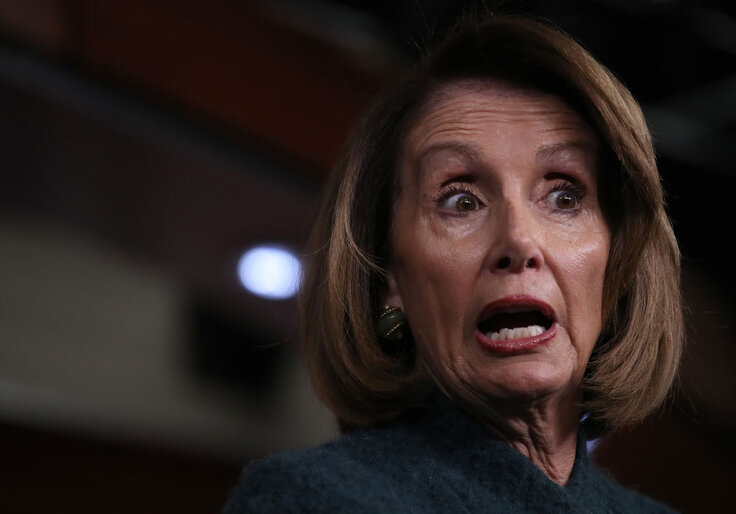As Americans await tonight's election results, political observers and the country's top journalists have based their predictions, and their reporting, in large part on the final polls released last week. But many of these polls are likely to differ substantially from the final outcomes.
NBC News, for example, released its final national survey on Sunday. Chuck Todd trumpeted the results on Sunday's Meet the Press: Democrats and Republicans are tied at 47 percent on the "generic" congressional ballot, and among likely voters in the same survey, Democrats now hold a 1-percentage-point lead.
While NBC's survey likely buoyed Democrats, an analysis of the poll and the results of other recent surveys—as well as NBC's polling history—suggests these generic ballot numbers may be inaccurate. For starters, since 2014, NBC's final generic ballot poll has never shown Republicans in the lead. You read that right. Even in 2014 and 2016, when Republicans won substantial congressional majorities, NBC News's polls didn't show the GOP with an advantage.
Over the last four cycles, NBC has overestimated Democrats' strength on the generic congressional ballot by an average of 2.5 percentage points. Adjusting Sunday's poll through that lens—that is, taking into account NBC's historic 2.5-percentage-point overweighting of Democrat strength—turns this poll's 1-point Democratic lead among likely voters into a 1.5-point edge for the GOP. That brings this poll in line with other generic ballot polls released since Oct. 20, which collectively show a 2.5-point Republican lead.
This 2.5-point Republican edge, should it materialize, would likely result in disproportionate Republican gains in the House because Democratic voters in many populous states tend to be clustered in a small number of districts. That's also why Republicans have typically won more seats than their congressional ballot support would suggest, and a GOP win by 2 or 3 points in the total congressional vote is likely to translate into a substantial Republican majority in Congress.
NBC has hardly been alone in terms of polling error. Political polling in general has come under scrutiny in recent years, especially since Donald Trump's unexpected 2016 victory over Hillary Clinton—unexpected, that is, because the polls had not predicted it. Speculation about the causes has ranged from the view that a growing number of voters, primarily Republicans, are unwilling to share their opinions with pollsters, to the suspicion on the right that some pollsters or their media cook results when they weight samples or develop turnout models. Whatever the reason, polls have become less reliable.
So, what can be done about it?
For starters, it's important to understand that some pollsters have better track records than others. Just because a poll's sponsor is a prominent media company doesn't mean the polls are accurate: For example, ABC News's final pre-election poll in 2020 showed Joe Biden winning Wisconsin by 17 points. He won by 0.7 points.
What matters is how accurate a pollster's performance has been in recent election cycles. To that end, viewing a poll's current results through the frame of the pollster's historic performance is useful. At the Polling Monitor, we provide those data for every pollster in every battleground state on our website.
Using this system, we calculate a so-called adjusted result. Here are some highlights of our adjusted results for key Senate races. Given how close many of the races are, voter turnout efforts—and voter enthusiasm—are likely to decide many of these contests. Most polls suggest that the GOP has an edge in that metric, and, if so, it could well make the difference.
Ohio:
The race was tight at one point, but recent polls in the matchup between Republican J.D. Vance and Democrat Tim Ryan show Vance pulling ahead. Taking into account past pollster performance, our Polling Monitor Adjusted Result has Vance leading by nearly 7 points.
Pennsylvania:
In perhaps the most closely followed Senate race in the country, our Polling Monitor Adjusted Result has Republican Mehmet Oz leading Democrat John Fetterman by just over 1 point.
Georgia:
In another closely watched race, our Polling Monitor Adjusted Result has a virtual dead heat between Republican Herschel Walker and incumbent Democrat Raphael Warnock. With both candidates polling under the 50 percent threshold needed for victory in the state, the contest is likely to go to a runoff.
Nevada:
Most recent public polls have shown Republican challenger Adam Laxalt with a slight lead in his race against incumbent Democrat Catherine Cortez Masto. Our Polling Monitor Adjusted Result shows Laxalt up by a more comfortable margin of 3 points.
In Nevada's race for governor, recent polls show Republican Joe Lombardo with a small lead over Democrat Steve Sisolak. But like Laxalt, our Polling Monitor Adjusted Result has Lombardo leading by almost 3 points.
Arizona:
Incumbent Democrat Mark Kelly has led every public poll in Arizona this year, but our Polling Monitor Adjusted Result has the race in a virtual dead heat, with Kelly leading Republican challenger Blake Masters by less than a point.
In Arizona's gubernatorial race Republican Kari Lake has edged ahead of Democrat Katie Hobbs, and our Polling Monitor Adjusted Result has Lake 3 points in front.
Wisconsin:
Incumbent Republican Ron Johnson has opened a small but consistent lead over Democrat Mandela Barnes in public polls, and our Polling Monitor Adjusted Result has Johnson ahead by slightly more than 4 points.
In the Wisconsin governor's contest, public polls have given Republican challenger Tim Michels a narrow lead over incumbent Democrat Tony Evers. Our Polling Monitor Adjusted Result has Michels up by just under 2 points.
Spencer Abraham is cofounder of the Polling Monitor.
